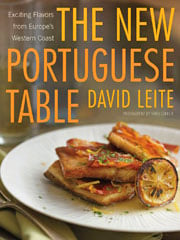
Cookies aren’t exactly a specialty of the Portuguese. Traditionally, they tend to be crumbly and plain, more like dunking biscuits.
One day at a dinner party, though, I had a sweet, thin cookie with a distinctive snap. I immediately made copious notes in my little black book, nibbling one cookie after the next so as to discern their many nuances. The only thing is, I never asked the hostess for the recipe.
I spent months trying to come up with a cookie that matched hers, and finally, I think I’ve done her proud. But I ratcheted up the recipe, adding two iconic Portuguese flavors to the mix: olive and lemon.
Serve these cookies alone, as an accompaniment to tea, or, my favorite, as a crunchy little something alongside a scoop of vanilla ice cream or lemon sorbet.

Portuguese Sweet Lemon-Olive Cookie
Ingredients
- 1 1/2 cups all-purpose flour
- 1/2 cup oil-cured black olives, rinsed quickly if particularly salty, pitted, and coarsely chopped
- 1/4 cup granulated sugar, plus more for coating
- 1/4 teaspoon baking powder
- 2 tablespoons grated lemon zest, preferably organic
- 1/8 teaspoon ground cinnamon
- Pinch of kosher salt
- 1/4 cup extra-virgin olive oil
- 1 large egg, beaten
Instructions
- Position a rack in the upper third of the oven and crank up the heat to 375°F (190°C). Cut 3 pieces of parchment paper cut to fit your baking sheet.
- Stir together the flour, olives, sugar, baking powder, lemon zest, cinnamon, and salt in a medium bowl. Whisk together the oil and egg, pour the mixture into the dry ingredients, and mix with your hands until the dough no longer looks dry and holds together when squeezed, 1 to 2 minutes.
- Fill a small bowl with sugar and set nearby. Pinch off 1 rounded tablespoon (about 1 ounce) of dough, roll it into a ball, and coat it well with sugar. Place the parchment paper on your work surface and place the dough ball near one corner of the parchment. Place another piece of parchment on top and, using a rolling pin, roll the ball into a 3 1/2- to 4-inch circle that’s a scant 1/16 inch thick. The edges of the cookie will be ragged; that’s how it should be. Repeat with 4 or 5 more wafers on the same sheet. Lift off the top sheet of parchment and slip the parchment with the cookies onto the baking sheet.
- Bake until the lemon-olive cookies are edged with brown and pebbled on top, 10 to 12 minutes. Slide the parchment onto a wire cooling rack. Repeat with the remaining dough, using a new piece of parchment for each. Once cooled, the cookies will keep in an airtight container for several days, but I doubt they’ll stick around that long.

Nutrition
Nutrition information is automatically calculated, so should only be used as an approximation.










This is what comes of boring Monday nights– and because these are so simple, I gave them another whirl. One problem I used twice as much sugar as called for.but then, too much sugar isn’t generally a problem when it comes to cookies– though it might blunt the olives to a degree.
They also needed a little more olive oil to form a dough this time, but still good.
My ‘pressing method’ is to lay the parchment out right in the baking pan and put the balls of dough directly on. I then cover them with the next piece of parchment, roll, and then use the topmost piece of parchment for the next batch. Worked just fine.
Hi Chris,
Thanks so much for divulging your pressing method. So glad that you liked the results!
Beth
Chris, glad you tried them again. Did you use oil-cured olives? The extra sugar might have accounted for the need for a bit more olive oil.
Made these twice now; first with oil-cured olives which definitely gives the cookies a punch in the taste profile in terms of contrast. Deferring to my wife’s preference, I used canned, chopped black olives which were much more uniform in size (advantage) but lacked that extra punch. Regardless, the cookies were still tasty but with more of a lemon tang.
I’m giving half of the pile to a Portuguese/Filipino friend via Macao, now living in the Bay Area.
We have your new book in our store, The Spanish Table in Berkeley.
Chris, thanks for the kind words about the recipe. Yes, it definitely needs the oil-cured olives, as it offers (as you say) more of a punch. And tell your friendly Spanish Table I thank them mightily for stocking my book.
Dear Mr. Leite,
Since I do lurk around on your Culinaria now and then, and have for some time, it came as a big surprise to me that I missed the Portuguese Sweet Lemon and Black Olive Cookie recipe from a couple years ago.
Now I’ve found it and I wanted to share my technique. I hate rolling pins. My idea of pastry dough is something very rustic that bakes atop a lovely tarte tatin. But I like the look of rough edges on a cookie and have solved my problem by using a tortilla press with some parchment squares. Photo attached.
On the cookies: delicious. I used about half as much lemon zest (I wanted the olives to shine) and, after the first batch came out, I sprinkled a few grains of fleur du sel on top, after pressing. Yum.
These are great in the repertoire for when vegan friends come over. If they don’t like olives, they don’t come over.
Thank you very much,
Christine Houston
Long Beach, CA
Christine, I find your technique utterly ingenious. I don’t own a tortilla press, but I’m sure some of our rolling-pin phobic readers might. And what I think is great is you get a perfect, even thickness, which helps in the baking. I’m so glad you sent this to us. Thank you!